Authentic Hungarian Goulash (Gulyás)
This post may contain affiliate links. See my disclosure policy.
A thoroughly authentic Hungarian Goulash recipe with a depth and richness of flavor that will satisfy both body and soul. Hungary’s national dish, this traditional gulyás captures everything that has made this dish so beloved across the globe. It is simply out-of-this-world delicious!
For more traditional Hungarian recipes be sure to also try my Chicken Paprikash, Bean Goulash, Pörkolt, and Szegedin Goulash!
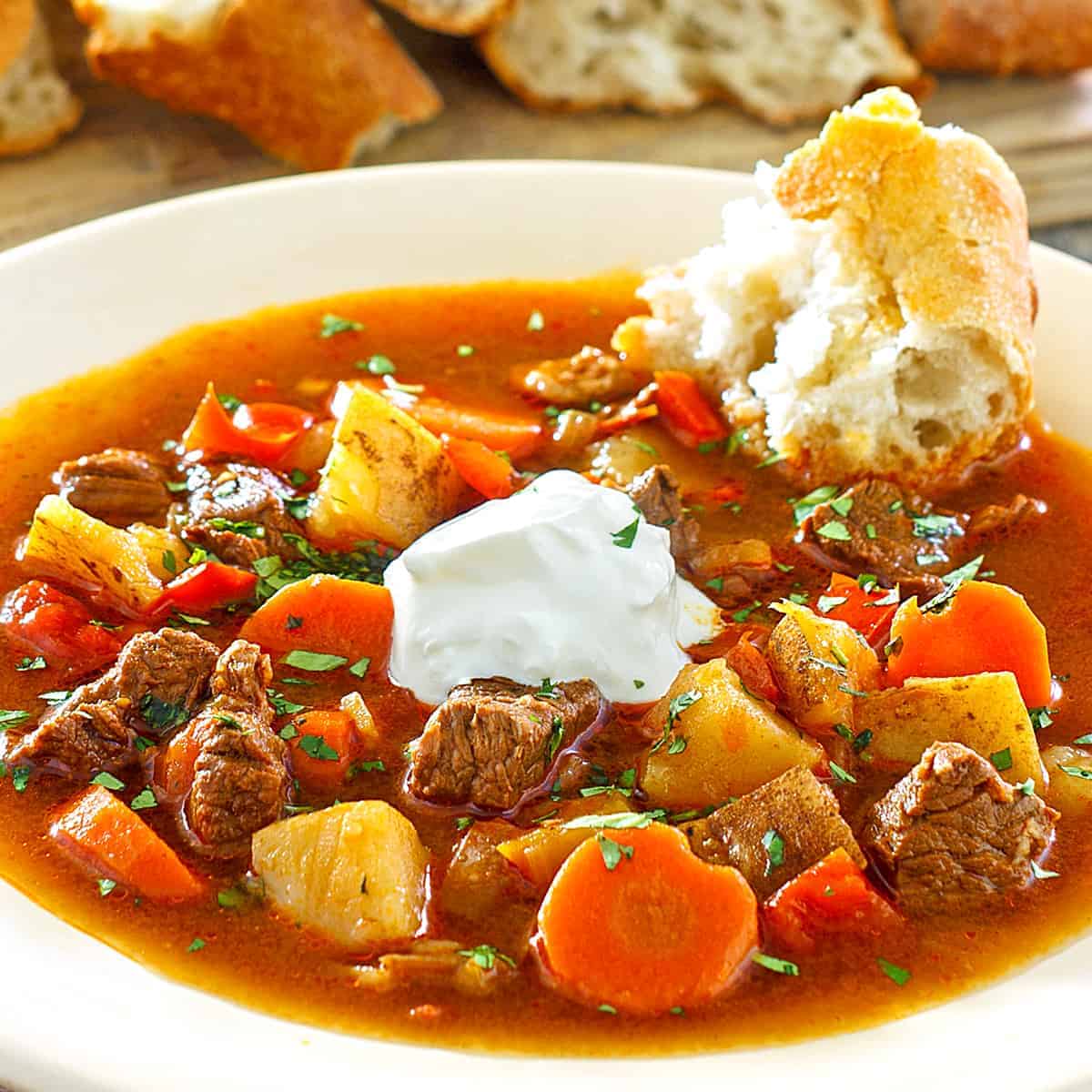
Traditional Hungarian goulash is a prime example of how a few simple ingredients, cooked properly, can yield an incredible flavor. Though many variations of Hungarian goulash exist, and every cook makes it just a bit differently, this is an authentic recipe from the heart of Hungary.
Hungary holds a special place in my heart and in my family’s hearts. My brother lived there for a couple of years and would always describe its beautiful scenery and architecture and his love for the Hungarian people. When I visited Budapest for the first time I immediately fell in love with it. Its name comes from the two sides of the city (Buda and Pest) separated by the Danube River running through it. With its striking chain bridge, stunning parliament building, and its incredible Buda Castle, Budapest is a breathtaking city.


Hungary’s history has been one of hardship and heartbreak. But the passion and stamina of soul has remained in the hearts of the Hungarian people. I’ve always been touched by Hungary’s national anthem, Himnusz, or “hymn”, written by the poet Kölcsey. Their anthem is a poetic prayer and unlike most anthems that focus on an expression of national pride, the Hungarian anthem is a direct, heartfelt plea to God. In the mid-20th century, during the years of strongest communist rule in Hungary, the words were not sung, only the music was played. The communist government asked two of the most acclaimed artists of that time, a poet and composer, to rewrite the national anthem. Both refused. The next communist leader also tried, unsuccessfully, to have it changed. And so Hungary’s national anthem remains Himnusz and its first three lines read:
O God, bless the nation of Hungary
With your grace and bounty
Extend over it your guarding arm

I also love Hungarian food. Their breads and smoked sausages are fantastic as are their meats, stews, sauces, and desserts. Today I’m going to share the national dish of Hungary: Goulash.
What is Hungarian Goulash?
Contrary to popular belief here in the U.S., Hungarian goulash is NOT made with ground beef or macaroni noodles! Traditional Hungarian goulash is an entirely different dish.
Goulash, or as Hungarians call it, gulyás, means “herdsman.” Its origins date back to the 9th century Magyar shepherds as a simple meat and onion stew prepared in heavy iron kettles known as bogracs. In the 15th century invading Ottoman Turks introduced a new spice to Hungary, paprika. While the rest of Europe remained lukewarm towards this red chili pepper from the New World, Hungary embraced it and paprika has since become a defining element of Hungarian cuisine.
Goulash is kind of in between a soup and a stew. Unlike some stews, Goulash is not overly packed full of beef and vegetables, it is a little more brothy. But through the cooking process, the broth becomes a little thicker and very rich in flavor.
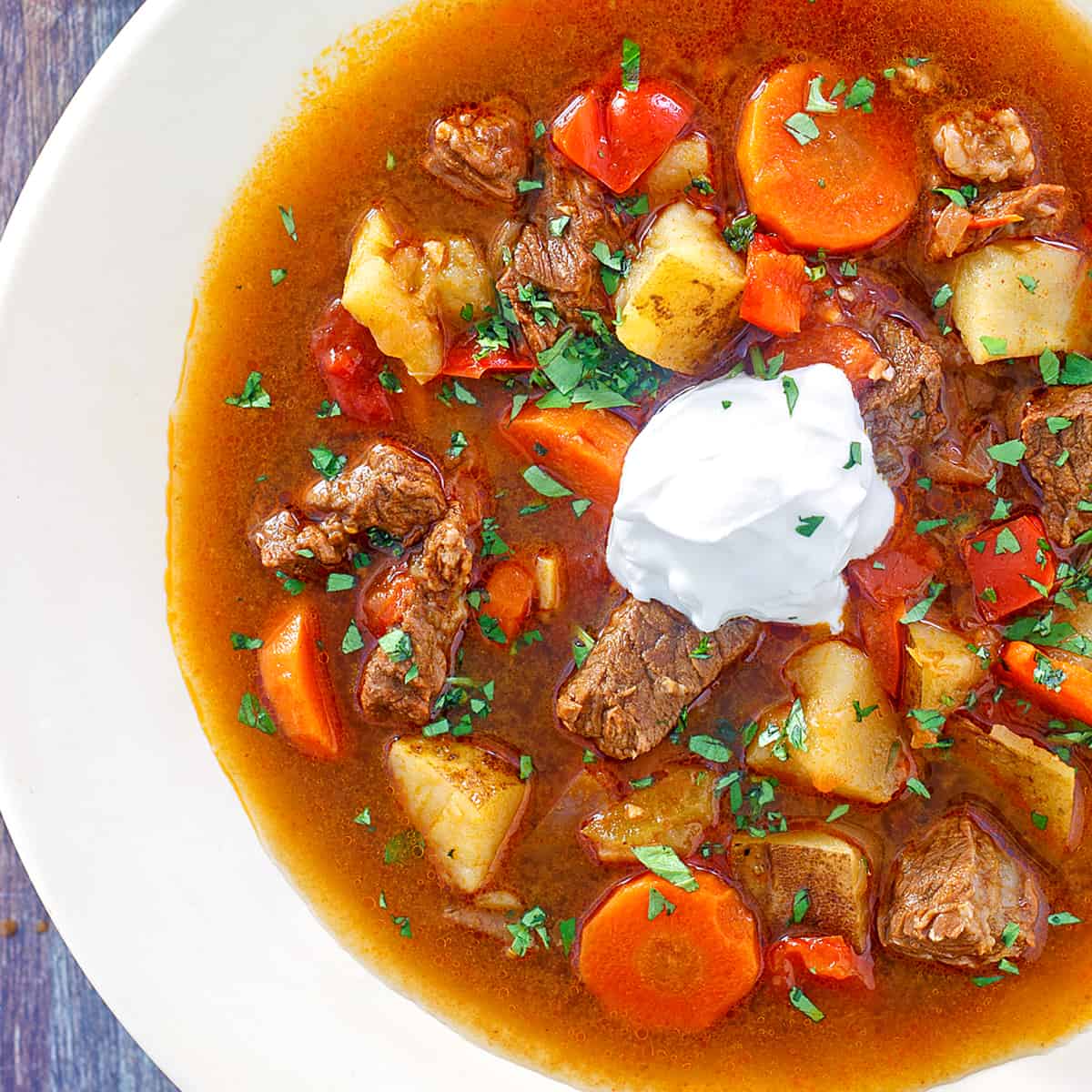
Tips for Authentic Hungarian Goulash
To achieve the ultimate flavor, the cooking method is important and quality, real Hungarian paprika is essential. And lots of it! None of this “2 teaspoons of paprika” jazz. Hungarians use very generous amounts of paprika, and that’s key. A Hungarian once told me, “however much paprika the recipe calls for – at least double or triple it!”
For this size batch of Goulash, you want to use a full 1/4 cup of it. When I lived in Germany, Hungary was just a few hours away and I would stock up on it when I visited. Now I order it online and recommend this genuine imported Hungarian paprika imported from Hungary. There is no comparison in flavor. It has an extraordinarily rich flavor and an exceptionally vibrant red color. Many of our readers have tried it and agree that quality Hungarian-imported paprika makes all the difference.
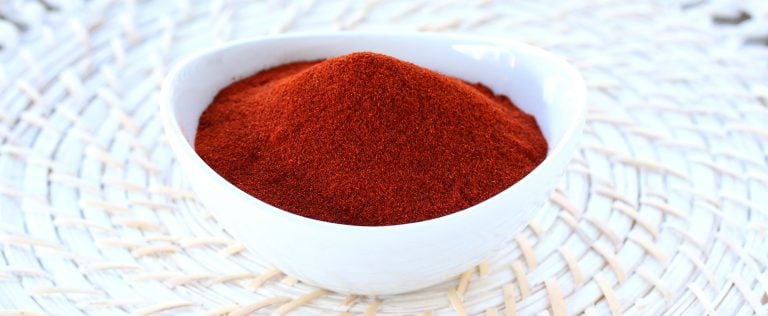
I mentioned earlier, many variations of goulash exist. Some include turnip or wine or caraway seeds, to name a few. But this recipe is a very old, very traditional way of making Goulash that my brother and I learned from older generations of Hungarian women and it needs no embellishments. It’s simple and simply delicious!
What’s the Best Dutch Oven to Use?
For this recipe, I recommend using a Dutch oven because it seals in the flavors and heats evenly, ensuring consistent cooking results. I love this 6-quart, budget-friendly option from Lodge, which you can get on Amazon for around $80. Or, if you’re looking for a worthy splurge, I also have this one from Le Creuset, which sells for around $300.
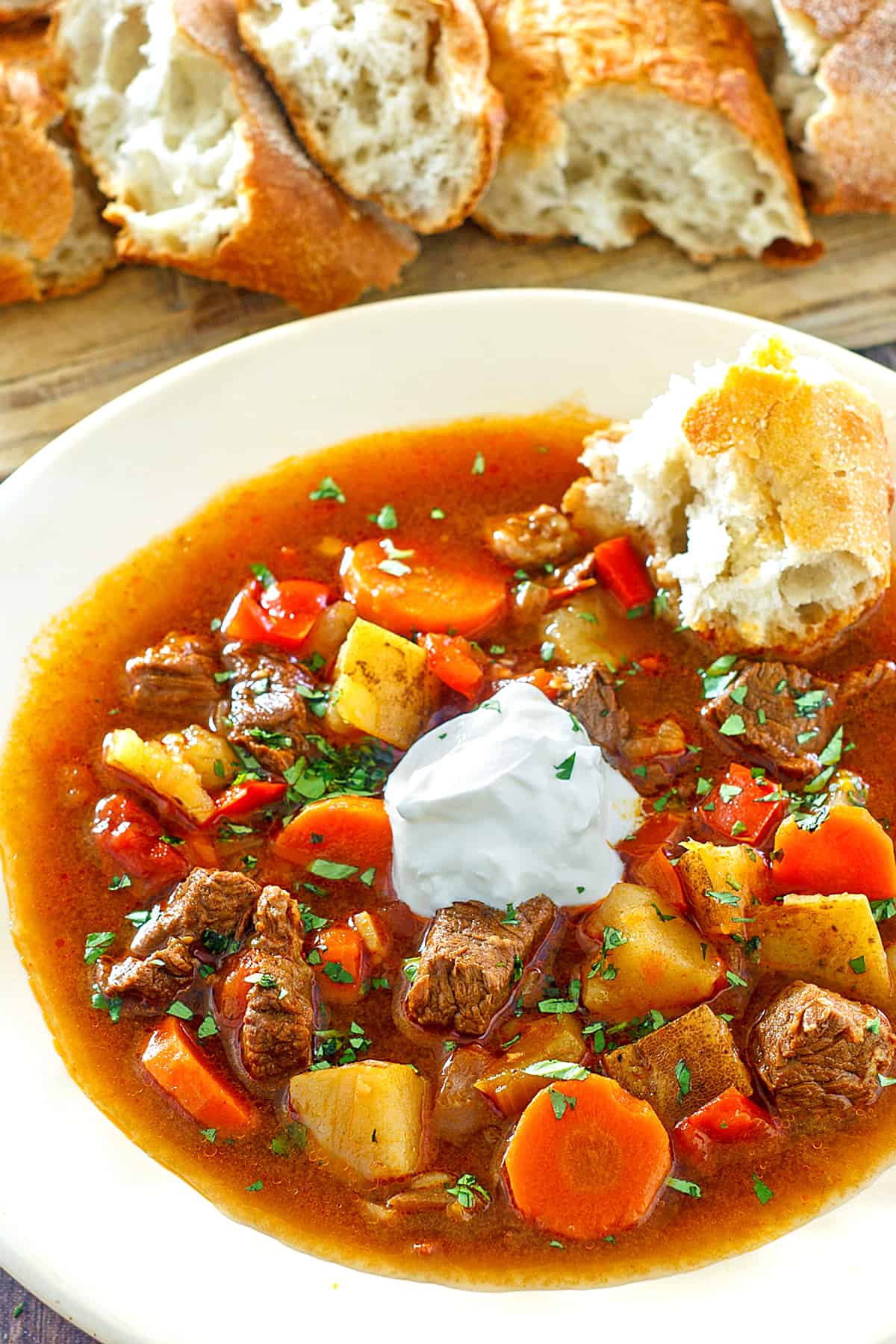
Hungarian Goulash Recipe
Let’s get started!
Melt the lard or butter/oil in a Dutch oven or other heavy soup pot over medium high heat and cook the onions until beginning to brown, about 7-10 minutes. Add the beef and cook until the beef is just starting to brown, 7-10 minutes.
Add the bell peppers, tomatoes, and garlic and cook for another 6-8 minutes. (Note about peppers: Outside of Hungary it’s very difficult to find the peppers they use there. The best ones to use in their place are red and some yellow/orange. Avoid regular green bell peppers as they have a starkly different flavor profile.)
Remove the pot from the heat and stir in the paprika, salt, pepper and caraway (if using) (note: paprika becomes bitter if at all scorched).
Add the beef broth, bay leaf, return to the stove and bring to a boil. Reduce the heat to medium-low, cover and simmer for 40 minutes. Add the carrots and potatoes. Return to a boil, reduce the heat to medium-low, cover, and simmer for another 30-40 minutes or until the beef is nice and tender. Add salt to taste. Remove the bay leaf.
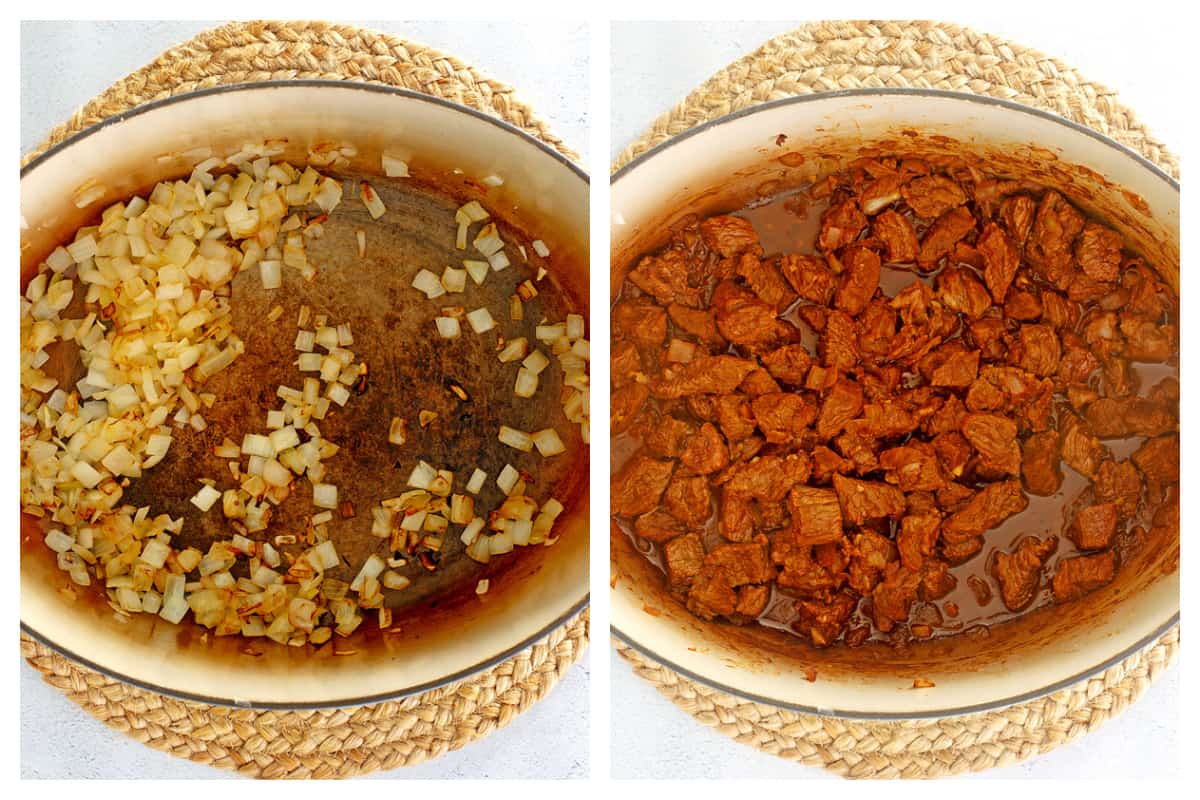
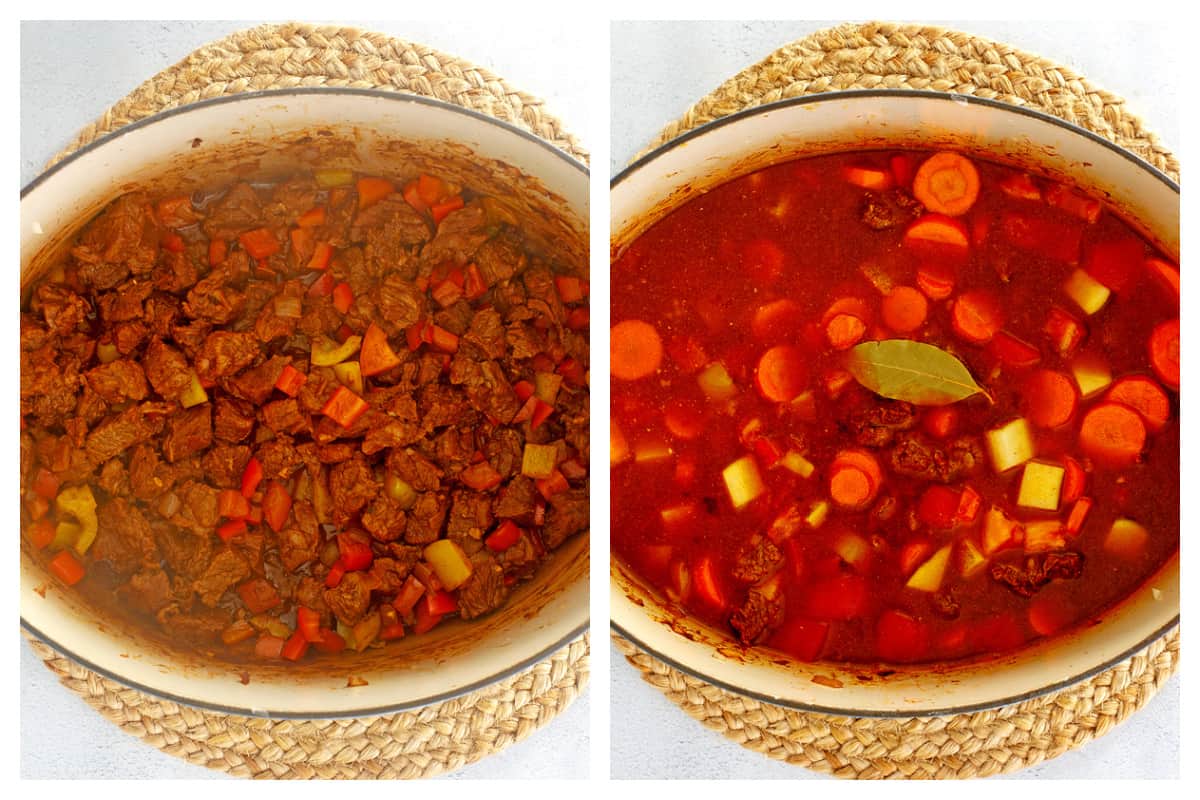
Serve with some crusty bread and, if desired, a dollop of sour cream.
Enjoy!
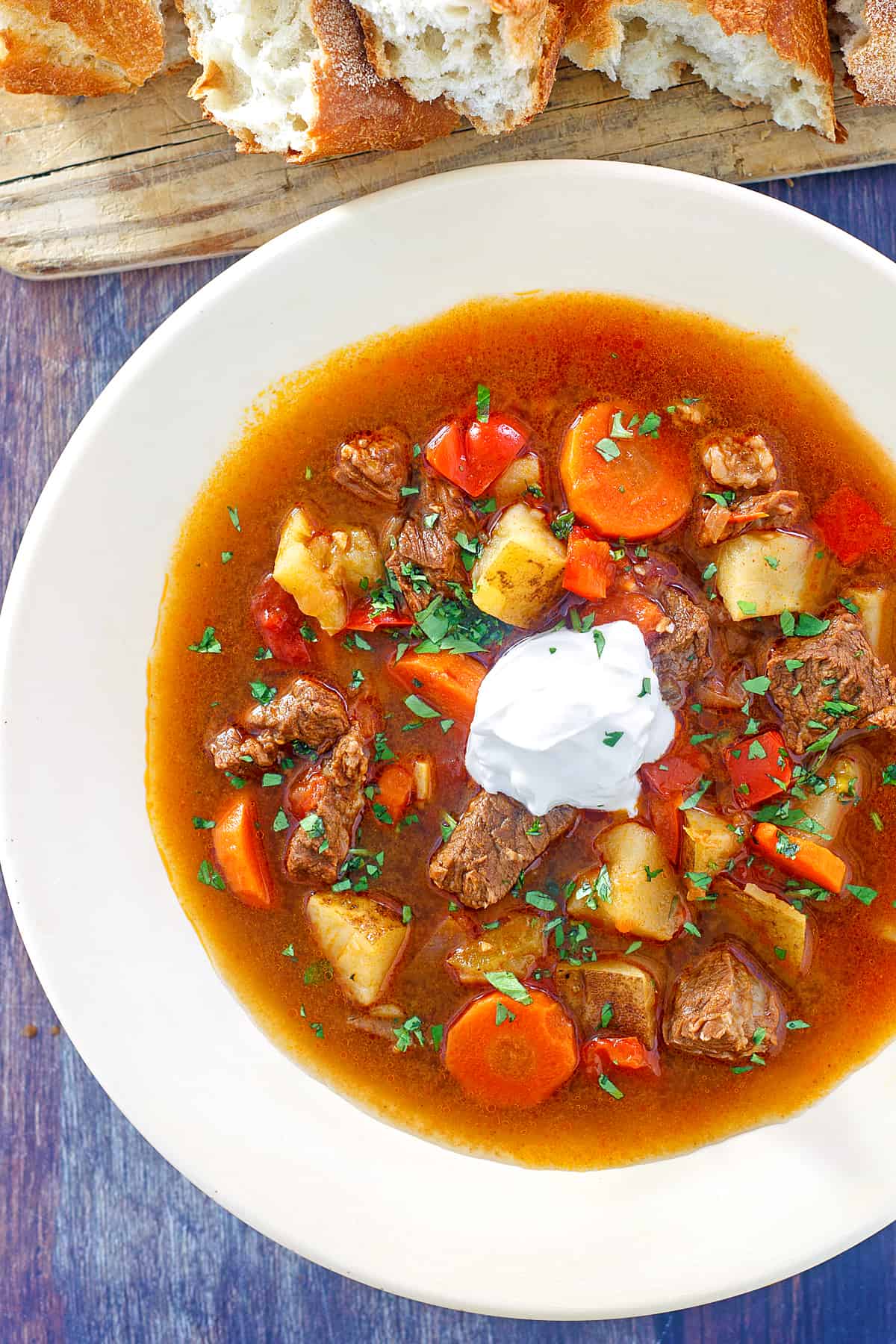
For more authentic Hungarian dishes, be sure to try my:
Save This Recipe
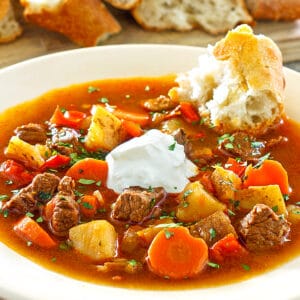
Authentic Hungarian Goulash (Gulyás)
Ingredients
- 3 tablespoons pork lard , or butter or bacon grease (pork lard is traditionally used and imparts a great flavor)
- 1 1/2 pounds yellow onions chopped
- 1/4 cup quality genuine imported Hungarian sweet paprika
- 1 1/2 pounds stewing beef , cut into 1/2 inch pieces
- 5 cloves garlic ,minced
- 2 red bell peppers ,seeded/membranes removed, cut into 1/2 inch chunks
- 1 yellow bell pepper ,seeded/membranes removed, cut into 1/2 inch chunks
- 2 tomatoes ,diced
- 2 carrots ,diced
- 2 medium potatoes ,cut into 1/2 inch chunks
- 5 cups beef broth (traditionally just water is used but beef broth adds so much more flavor)
- 1 bay leaf
- 1 teaspoon salt
- 1/2 teaspoon freshly ground black pepper
- 1/2 teaspoon crushed caraway seeds (optional, not traditional in all regions)
Instructions
- Melt the pork lard or butter/oil in a Dutch oven or other heavy soup pot over medium high heat and cook the onions until beginning to brown, about 7-10 minutes. Add the beef and cook until the beef is just starting to brown, 7-10 minutes. Add the bell peppers, tomatoes, and garlic and cook for another 6-8 minutes. Remove the pot from the heat and stir in the paprika, salt, pepper and caraway (if using) (note: paprika becomes bitter if at all scorched). Add the beef broth, bay leaf, return to the stove and bring to a boil. Reduce the heat to medium-low, cover and simmer for 40 minutes. Add the carrots and potatoes. Return to a boil, reduce the heat to medium-low, cover, and simmer for another 30-40 minutes or until the beef is nice and tender. Add salt to taste. Remove the bay leaf.
Nutrition
Originally published on The Daring Gourmet on March 18, 2014
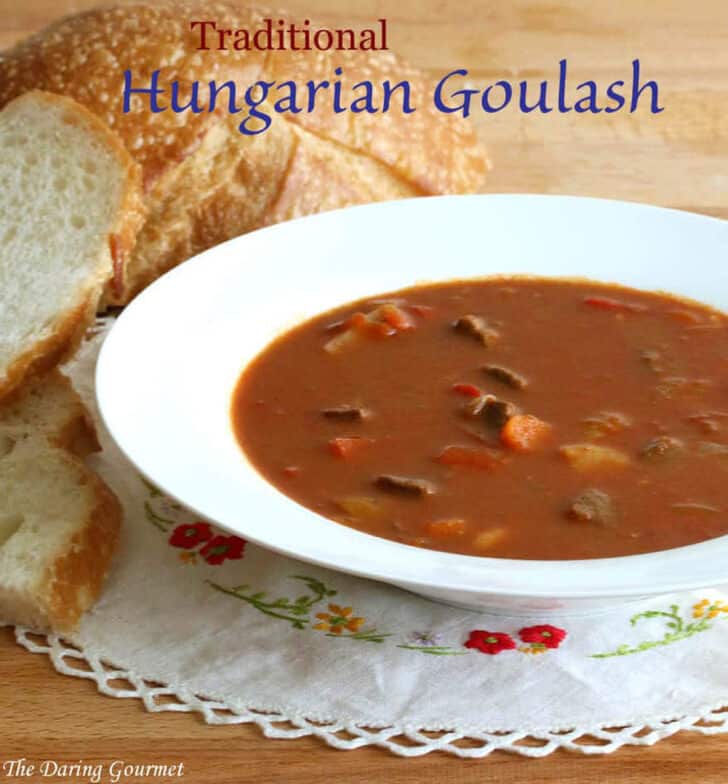



















Hello! I made this dish for my family last night and it turned out to be a big hit with them! Given how simple the ingredients are with such few seasonings (we’re Indian and conditioned for a lengthy list of spices for some traditional recipes lol) it packed in a LOT of flavor. Bookmarking this to make again. The recipe is super but I used lesser stock (abt 3-1/2 to 4cups) and just 1 red bell pepper instead of the recommended two. Also I made just 1 teeny tiny addition-
I had just about 1/4c of fresh beet juice left over from another dish I was making along side. Poured that into my goulash and the color was INCREDIBLE! Fortunately couldn’t taste the beets at all
Hi Tanya, that’s wonderful! So happy to hear it was a hit! I know, I always marvel at how much flavor some thing pack even though they have such few and simple ingredients. A lot of it has to do with the method of cooking. And that paprika flavor is simply fabulous! I’ll bet the color was very rich indeed with the beet juice. Thanks for the feedback! Best, Kimberly
Hi Kimberly- I was trying to find a new hearty soup to make, something different from the usual beef vegetable and bean soups I usually make in the winter, when I came across your goulash recipe. I made it today and it was simply delicious. I don’t recall ever trying a traditional Hungarian Goulash before. I found it to be slightly reminiscent to Beef Paprikash my parents made for us in my younger years . The goulash was delicious despite the fact I didn’t use good quality paprika- . Next time I make it, I will use the good quality stuff you recommend. Thank you for this great recipe that I am adding to my soup repertoire.
Thanks, Tim, I’m so glad you enjoyed it and really appreciate the feedback!
I have tried and loved many of your recipes and I can’t wait to make this. What cut of beef do you recommend for this goulash?
Thank you, Lisa, I really appreciate that! The nice part about stews is that you can pretty much use any cut of beef you like. If you use a tougher cut, like chuck, just follow the directions under “Note” in the recipe box to simmer it longer without the vegetables so they don’t get too mushy and then add the vegetables to cook for the remaining time. That way even a tough cut of meat will turn out deliciously tender. So it’s really just a matter of personal choice – a leaner cut for shorter cooking time, or a tougher cut for longer cooking time. I’ll be making another batch of this again soon as well. Enjoy!
The tomatoes, potatoes and peppers are all native to the Americas. This dish, in my opinion, seems like the stews and soups you find with people who are in hardship. My grandmother used to take random ingredients and find ways to make them work together. We’d eat the noodle based goulash because it was really just a mixture of what was there.
I can’t wait to try this recipe though!
Many dishes that have been around for centuries and remain popular today began as peasant dishes. French Coq au Vin is one of them and today it’s considered gourmet. Funny how perceptions change with time. Happy goulash-making, Brohamski!
A hundred years ago in rural fishing villages of Nova Scotia, folks were embarrassed to have “only” lobster to offer guests or put in children’s school lunches as it was considered the poorest food and mostly used for fertilizer. Imagine! Yes, things do change.
Wow, that’s amazing, Faye, and one I hadn’t heard before! Yes, things certainly do change :)
On CapeCod in the 1880 , the Servants went on strike , because they where sick of only getting lobster everyday . How times change!
I could see lobster bring good for cat food, but I wouldn’t recommend humans eat it.
Good one, Randy. Actually the season just opened on the eastern shore of Nova Scotia. I had one on the weekend, and yes, my three kitties did love it. One has the sniffles and is “too cute for school”, so got most of it. I’m guessing lobster isn’t your thing.
Paprika is made from peppers originally from the New World. So you could say paprika isn’t Hungarian.
…but that (red) paprika what Hungarian (so as I) use for goulash IS HUNGARIAN.
“The plant used to make the Hungarian version of the spice was grown in 1529 by the Turks at Buda[12] (now part of Budapest, the capital of Hungary).
Central European paprika WAS HOT until the 1920s, when a Szeged (Hungarian town) breeder found a plant that produced sweet fruit, which he grafted onto other plants.”
OMG GMO, GMO!!! Sorry, couldn’t resist. So many people freak out over GMO and they don’t realize that “GMO” has been going on since humans learned how to farm.
Yes! When we were lucky enough to visit Hungary in 2013, we toured the pepper factory in Szeged, where the peppers are grown and processed.
Daniel, Danube is German for Duna in Hungarian.
In Hungary we NEVER use butter in gulyas. Lard, or oil. Also, tomato is a maybe, green pepper small amount.
Always a tiny amount of whole caraway seed toasted with the meat. (Like to use shank or similar, never too dry meat!) Sometimes small hand pinched noodles used to make the stew richer.
Sour cream is a no for gulyas. We serve some kind of sweet to make the meal whole, usually made from yeast dough.
Hi Judith, thanks for your input. You’ll notice my instructions say “lard or butter” (lard being recommended first). Lard isn’t commonly used here. And it turns some people off. But yes, in authentic, traditional Hungarian gulyas, lard is used (and provides the most flavor). As for your sweeping statements of “NEVER” and “ALWAYS”, I’m sure you must be aware that there are are many variations of gulyas and one isn’t necessarily more correct than the other. I’ve eaten in many Hungarian restaurants in Hungary, and have eaten in the homes of several wonderful elderly Hungarian women in their 70’s and 80’s, and there have always been some variations. That’s true for any “traditional” recipe. There will always be variations depending on the traditions passed down by one’s family.
Well, thanks for the correction.Yes, you are right about slight variations of each household’s way of cooking even a so called traditional dish. Yes, the traditional way the gulyas – just as most cooking – was done with lard. Today very few household has lard in their pantry even in Hungary, and that is for ‘special’ dishes only.
Thanks for posting, I do enjoy the spice mixes, I’ve been looking for THE gyro spice. Can’t wait to try yours.
Thanks, Judith, let me know what you think of the Greek seasoning blend. We’re all big fans of the homemade gyros using this blend and the homemade tzatziki sauce. It’s a regular family favorite. Happy cooking!
Can you please send me the gyro recipe’ I’m sure it is delicious. The goulash was absolutely amazing!
Thanks, Steve, I’m glad you enjoyed it! Here is the recipe for the homemade gyros: https://www.daringgourmet.com/gyros-with-tzatziki-sauce/
I think the issue is to call it “traditional”. Simply omit that and there won’t be any problem. Unfortunately, visiting a country, and eating at their restaurants and households does not make anyone an aothority to call a recipe from that country’s “traditional” as it never tastes the same when made by someone else somewhere else. I’ve used “never” here and I really mean it as a result of my experience of living in many countries over the last 30 years due to work . I’m a member of an ethnic community living in the U.K now and even my own food does not taste the same as home when made with the ingredients bought here. In addition, as you say, there are individual differences added by each cook. So let’s leave the “traditional” title to those who truly deserve it and live happily after.
The term “traditional” simply means time-honored, long-established and conventional. In other words, this is a classic version of Hungarian goulash – not a modern interpretation of it. Whether the garlic was grown in Hungary or Africa, or the cow was grazed in Germany or Argentina, this is the traditional method of preparation.
Wrong Kimberly, the cow grazed in Germany eats different type of grass to its Argentinian cousin, ergo, different flavour. I’m a professional chef as no doubt are you.
That is true, Kieran, but that wasn’t the point of my comment. To reiterate what I responded earlier: The term “traditional” by definition simply means time-honored, long-established and conventional. In other words, this is a classic version of Hungarian goulash – not a modern interpretation of it. The method of preparation of this goulash, as well as the types of ingredients used, is traditional.
I am a native of Hungary. I agree with you about using substitutes for lard and that each home has its own variation of the same recipe. Hungarians still use too much lard for my taste (even in desserts). Your recipe looks delicious. Also to some of the other commenters: please cut the author some slack. I appreciate this blogger’s passion and openness to try different cuisine and attempt to recreate the cultural classics on a foreign soil. I give thumbs up ;)
Amen….well said…arguing with the author over a word? Ffs!
To the author, thank you for taking the time to share and blog (which always takes much time).
I’m going to try you gouly. My parents are Serbian btw and like Hungary, each househould is entirely different in its approach, though never wavering too far. I’m 45, male and learnt to cook from my woggy parents. Mum makes a beautiful Serbian goulash (I.e. Hungarian). I love it and I few up on it. She uses a goulash spice (some Croatian brand). Being the creative type, I’ve played around with many versions and settled on the following:
– 2 large onions diced
– 1.5 kg chuck steak, large dices
– 1 large carrot chopped
– 2 large celery stalks chopped
– 2 teaspoons chopped garlic
– 3 bay leaves
– 3 tablespoons Paprika (half sweet / hot)….never smoked (it ruins the profile)!!!
– 2 tablespoons vegeta (croatian stock spice)
….and that’s it….2.5 hour slow cook time and Bob’s your uncle.
Comments:
– no potatoes as i like it over rustic mashed potatoe
– no red/yellow capsicums…not sure why I don’t lol
– no tomatoes – for me it creates a taste profile I dont like.
Gg
–
Thank you, George, and thanks for sharing!
Saving this recipe but also wonder if it can be made with pork loin?
Hi Cheryl, yes you can. It won’t have quite the same flavor profile or depth of flavor but it will still be yummy.
The first time I made goulash I used pork loin — my mother just laughed, “too dry you should use pork shoulder” She was a wonderful cook, the first child born here in the states to a couple from Budapest, Metz and Lietz families.
This brings back great memories. I am from Hungarian descent on my dad’s side, and had this and Chicken Paprikash as my favorites growing up. Our last name is Duna, which in German is Danube.
Awesome, Daniel! I love Hungarian food. More recipes to come!
Donau is German for Danube.
Quelle belle ville et quelle jolie cuisine hongroise …Je suis fan depuis très longtemps
Thank you very much, Bistro de Jenna! Budapest is a very beautiful city and Hungarian cuisine is fabulous. Thanks so much for visiting and for your kind words :)
I don’t know Hungarian, but I really enjoyed this recipe. We were in Hungary last month and wanted to try the goulash.This recipe was excellent, regardless of the verbal commentary back and forth between others, which was as absurd! I followed the recipe almost exactly, but it took 45 minutes longer than listed. The meal was excellent!
I’m so glad you enjoyed it, Erich, thank you!
This is by far the best goulash I’ve had and I’ve tried many recipes trying to recreate the ones I had in Hungary. Truly excellent!
Thanks so much, T. Foster!
This dish is amazing!!! I’m Hungarian but never had much of the cuisine, so happy to have found this dish. I did find Hungarian hot peppers at one of my local markets and I’m wondering how you would use them in this dish? Do you replace all the Bella with them or only some?
Traditional Hungarian Goulash (Gulyas). Delicious! http://t.co/u4Ap0FUgm3